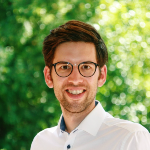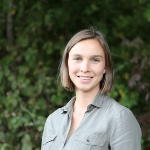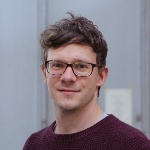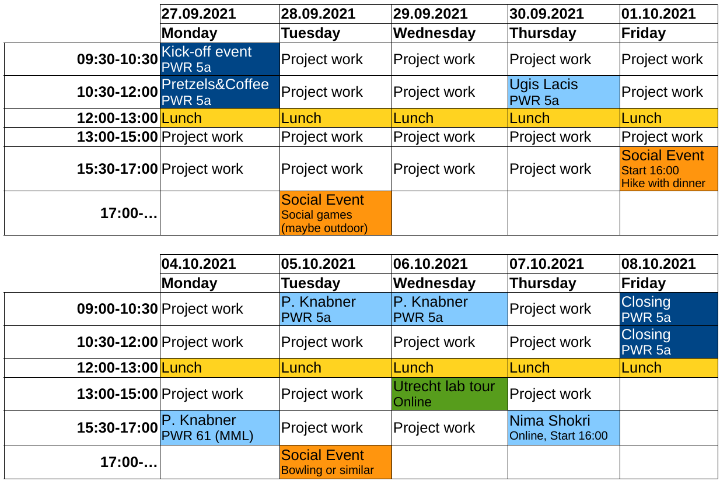The second SFB 1313 Summer School takes place from September 27 to October 8, 2021. All SFB 1313 doctoral researchers and associated researchers are invited to participate.
The SFB 1313 Summer School brings together doctoral researchers in small groups to work on specified research projects. A Kick-off event on the first day of the summer school, September 27, and a Closing event, where the result of the summer school are presented on October 8, give the doctoral researchers the opportunity to discuss their plans and findings with the principal investigators and external partners of SFB 1313.
We are happy to welcome our guests Prof. Dr. Nima Shokri (Hamburg University of Technology), Prof. Dr. Peter Knabner (Friedrich-Alexander Universität Erlangen-Nürnberg), and Dr. Ugis Lacis (KTH Royal Institute of Technology, Sweden) who will give lectures during the summer school and support the doctoral researchers with their expertise.
Projects
The doctoral researchers will work in groups on four different projects:
- Coupling free flow and porous-medium flow
- Time-resolved μ-XRCT scans of EICP in glass bead columns
- Salt precipitation: Pore network models – Phase Field Model coupling
- Biofilm formation in porous media
Programme
The Kick-off event gives the doctoral researchers the chance to present their ideas and plans for their project work in the coming two weeks.
Effective boundary conditions at porous (and elastic) materials: fluids and surfaces research group perspective.
In this presentation, I will first give an overview of myself and the research group I am working in (https://www.bagherigroup.com/). The common theme of the research group will be introduced. An overview of projects will be given, ranging from numerical investigations of rough and porous surfaces to an inauguration of a recent experimental facility.
In the second part of the talk, I will present the brief history of my work on the effective conditions suitable to couple flow through porous (and elastic) material with the overlying free flow. Different existing approaches will be summarized. Advantages and disadvantages will be discussed. The subtle question pertaining to the comparison between fully resolved results and effective predictions will be introduced. The main contributions from our group in this field will be explained. Possible future research directions will be discussed.
Mathematical Modeling of Mineral Precipitation/Dissolution Reactions in Porous Media
We will discuss the modeling of surface reactions with one participant with constant activity both in equilibrium and kinetically and the interaction with dispersive/convective transport processes. We will also elucidate the transition these models undergo upscaling from a pore to a Darcy scale, and indicate problems and possible remedies encountered in the solution of numerical approximations of these models.
Mathematical Modeling of Evolving Porous Media Driven by Surface Reactions
Several surface reactions in porous media such as mineral precipitation/dissolution, biofilm growth, aggregate formation,.. alter the structure of the porous medium and thus render the emerging fluid flow and dispersion-convection-reaction models to be free/moving boundary problems which require a description of the interface dynamics. We will discuss various approaches such as phase field models, level set or cellular automata descriptions.
The Best of Both Worlds: Micro-macro Models for Complex Porous Media Processes
Processes in porous media from a certain complexity on cannot be described sufficiently by macroscopic (Darcy scale) quantities alone, but typically need information about microscopic interfaces. This explains the upswing of pure pore scale modeling, which unfortunately only allows for small spatial domains. A new paradigm could be macroscopic models which incorporate information from microscopic processes. this not new idea goes under various names such as heterogeneous homogenisation, distributed micro structure models , two-scale models, FE_square models. After a short introduction in their appearance from upscaling processes we discuss their mathematical structure and consequences for their numerical complexity and algorithmic treatment.
Our external partners from Utrecht Universtiy Dr. Matthijs De Winter, Dr. Amir Raoof and Enno de Vries give us the opportunity to virtually visit their Multiscale Porous Media Lab at Utrecht University.
In the framework of the Pretty Porous Science Lectures Prof. Dr. Nima Shokri (Hamburg University of Technology) will give a talk about "Drying-dynamics-of-drops-of-complex-fluids".
During the closing event, the doctoral researchers present the results of their work in the summer school projects as well as discuss ideas for future cooperations.
Contact

Simon Emmert
Dr.-Ing.Alumnus: Postdoctoral Researcher, Associated Research Projects C04 and CX1, Project MGK

Elissa Eggenweiler
Alumna: Post-doctoral Researcher, Research Project A03

Johannes Eller
Dr.-Ing.Alumnus: Post-doctoral Researcher, Research Project A01



